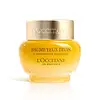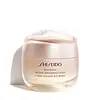What's inside
What's inside
 Key Ingredients
Key Ingredients

 Benefits
Benefits

 Concerns
Concerns

 Ingredients Side-by-side
Ingredients Side-by-side

Water
Skin ConditioningButyrospermum Parkii Butter
Skin ConditioningTheobroma Cacao Fruit Powder
Skin ConditioningCaprylyl Caprylate/Caprate
EmollientGlycerin
HumectantRosa Centifolia Flower Water
Skin ConditioningCetearyl Alcohol
EmollientSilica
AbrasiveOenothera Biennis Oil
EmollientGlyceryl Stearate
EmollientPEG-100 Stearate
Camelina Sativa Seed Oil
Skin ConditioningHelichrysum Italicum Flower Oil
MaskingHelichrysum Italicum Flower/Stem Extract
Skin ConditioningHelichrysum Italicum Extract
AntiseborrhoeicEchium Plantagineum Seed Oil
Skin ConditioningBorago Officinalis Seed Oil
EmollientMyrtus Communis Oil
MaskingHelianthus Annuus Seed Oil
EmollientAdenosine
Skin ConditioningHyaluronic Acid
HumectantEscin
TonicMethyl Methacrylate Crosspolymer
Hydroxyethyl Acrylate/Sodium Acryloyldimethyl Taurate Copolymer
Emulsion StabilisingCeteareth-33
CleansingCaprylyl Glycol
EmollientEthylhexylglycerin
Skin ConditioningTocopherol
AntioxidantXanthan Gum
EmulsifyingDisodium EDTA
Sorbitan Isostearate
EmulsifyingPolysorbate 60
EmulsifyingCaprylic/Capric Triglyceride
MaskingSucrose Palmitate
EmollientSodium Hydroxide
BufferingGlyceryl Linoleate
EmollientCitric Acid
BufferingSodium Benzoate
MaskingPhenoxyethanol
PreservativePotassium Sorbate
PreservativeWater, Butyrospermum Parkii Butter, Theobroma Cacao Fruit Powder, Caprylyl Caprylate/Caprate, Glycerin, Rosa Centifolia Flower Water, Cetearyl Alcohol, Silica, Oenothera Biennis Oil, Glyceryl Stearate, PEG-100 Stearate, Camelina Sativa Seed Oil, Helichrysum Italicum Flower Oil, Helichrysum Italicum Flower/Stem Extract, Helichrysum Italicum Extract, Echium Plantagineum Seed Oil, Borago Officinalis Seed Oil, Myrtus Communis Oil, Helianthus Annuus Seed Oil, Adenosine, Hyaluronic Acid, Escin, Methyl Methacrylate Crosspolymer, Hydroxyethyl Acrylate/Sodium Acryloyldimethyl Taurate Copolymer, Ceteareth-33, Caprylyl Glycol, Ethylhexylglycerin, Tocopherol, Xanthan Gum, Disodium EDTA, Sorbitan Isostearate, Polysorbate 60, Caprylic/Capric Triglyceride, Sucrose Palmitate, Sodium Hydroxide, Glyceryl Linoleate, Citric Acid, Sodium Benzoate, Phenoxyethanol, Potassium Sorbate
Water
Skin ConditioningSd Alcohol 40-B
AstringentGlycerin
HumectantDipropylene Glycol
HumectantNiacinamide
SmoothingCyclohexasiloxane
EmollientCetyl Ethylhexanoate
EmollientHydrogenated Polydecene
EmollientPhytosteryl/Octyldodecyl Lauroyl Glutamate
Skin ConditioningDimethicone
EmollientPPG-3 Dipivalate
Skin ConditioningMyristyl Myristate
EmollientMethyl Methacrylate Crosspolymer
Hydrogenated Palm Oil
EmollientAmmonium Acryloyldimethyltaurate/Vp Copolymer
Behenyl Alcohol
EmollientPolysorbate 60
EmulsifyingPEG-30 Phytosterol
EmulsifyingPhenoxyethanol
PreservativeDimethicone/Vinyl Dimethicone Crosspolymer
Skin ConditioningBatyl Alcohol
EmollientAlcohol
AntimicrobialTocopheryl Acetate
AntioxidantErythritol
HumectantPEG/PPG-14/7 Dimethyl Ether
Skin ConditioningPEG/PPG-17/4 Dimethyl Ether
Skin ConditioningButylene Glycol
HumectantParfum
MaskingCarbomer
Emulsion StabilisingAcrylates/C10-30 Alkyl Acrylate Crosspolymer
Emulsion StabilisingPotassium Hydroxide
BufferingCaffeine
Skin ConditioningDisodium EDTA
Sodium Metaphosphate
BufferingTocopherol
AntioxidantSapindus Mukorossi Peel Extract
Skin ConditioningCI 77492
Cosmetic ColorantLinalool
PerfumingSodium Metabisulfite
AntioxidantLimonene
PerfumingCitronellol
PerfumingAngelica Keiskei Leaf/Stem Extract
Skin ConditioningGeraniol
PerfumingCamellia Sinensis Leaf Extract
AntimicrobialCitrus Junos Seed Extract
AntioxidantHdi/Trimethylol Hexyllactone Crosspolymer
Ziziphus Jujuba Fruit Extract
Skin ConditioningCI 77491
Cosmetic ColorantEucheuma Serra/Grateloupia Sparsa/Saccharina Angustata/Ulva Linza/Undaria Pinnatifida Extract
EmollientCurcuma Longa Rhizome Extract
Skin ConditioningSaccharina Angustata/Undaria Pinnatifida Extract
EmollientChlorella Vulgaris Extract
Skin ConditioningSilica
AbrasiveWater, Sd Alcohol 40-B, Glycerin, Dipropylene Glycol, Niacinamide, Cyclohexasiloxane, Cetyl Ethylhexanoate, Hydrogenated Polydecene, Phytosteryl/Octyldodecyl Lauroyl Glutamate, Dimethicone, PPG-3 Dipivalate, Myristyl Myristate, Methyl Methacrylate Crosspolymer, Hydrogenated Palm Oil, Ammonium Acryloyldimethyltaurate/Vp Copolymer, Behenyl Alcohol, Polysorbate 60, PEG-30 Phytosterol, Phenoxyethanol, Dimethicone/Vinyl Dimethicone Crosspolymer, Batyl Alcohol, Alcohol, Tocopheryl Acetate, Erythritol, PEG/PPG-14/7 Dimethyl Ether, PEG/PPG-17/4 Dimethyl Ether, Butylene Glycol, Parfum, Carbomer, Acrylates/C10-30 Alkyl Acrylate Crosspolymer, Potassium Hydroxide, Caffeine, Disodium EDTA, Sodium Metaphosphate, Tocopherol, Sapindus Mukorossi Peel Extract, CI 77492, Linalool, Sodium Metabisulfite, Limonene, Citronellol, Angelica Keiskei Leaf/Stem Extract, Geraniol, Camellia Sinensis Leaf Extract, Citrus Junos Seed Extract, Hdi/Trimethylol Hexyllactone Crosspolymer, Ziziphus Jujuba Fruit Extract, CI 77491, Eucheuma Serra/Grateloupia Sparsa/Saccharina Angustata/Ulva Linza/Undaria Pinnatifida Extract, Curcuma Longa Rhizome Extract, Saccharina Angustata/Undaria Pinnatifida Extract, Chlorella Vulgaris Extract, Silica
 Reviews
Reviews

Ingredients Explained
These ingredients are found in both products.
Ingredients higher up in an ingredient list are typically present in a larger amount.
Disodium EDTA plays a role in making products more stable by aiding other preservatives.
It is a chelating agent, meaning it neutralizes metal ions that may be found in a product.
Disodium EDTA is a salt of edetic acid and is found to be safe in cosmetic ingredients.
Learn more about Disodium EDTAGlycerin is already naturally found in your skin. It helps moisturize and protect your skin.
A study from 2016 found glycerin to be more effective as a humectant than AHAs and hyaluronic acid.
As a humectant, it helps the skin stay hydrated by pulling moisture to your skin. The low molecular weight of glycerin allows it to pull moisture into the deeper layers of your skin.
Hydrated skin improves your skin barrier; Your skin barrier helps protect against irritants and bacteria.
Glycerin has also been found to have antimicrobial and antiviral properties. Due to these properties, glycerin is often used in wound and burn treatments.
In cosmetics, glycerin is usually derived from plants such as soybean or palm. However, it can also be sourced from animals, such as tallow or animal fat.
This ingredient is organic, colorless, odorless, and non-toxic.
Glycerin is the name for this ingredient in American English. British English uses Glycerol/Glycerine.
Learn more about GlycerinThis ingredient comes as a powder made up of small, porous, microbeads. It is used to add a silky feel to products and also helps absorb oil.
Phenoxyethanol is a preservative that has germicide, antimicrobial, and aromatic properties. Studies show that phenoxyethanol can prevent microbial growth. By itself, it has a scent that is similar to that of a rose.
It's often used in formulations along with Caprylyl Glycol to preserve the shelf life of products.
Polysorbate 60 is used to help stabilize products. It is a surfactant and emulsifier. These properties help keep ingredients together in a product. Surfactants help reduce surface tension between ingredients with different states, such as liquids and solids. Emulsifiers help prevent oils and waters from separating.
Polysorbate 60 is sorbitol-based and created from the ethoxylation of sorbitan. Ethoxylation is a chemical reaction used to add ethylene oxide. Sorbitan is a the dehydrated version of sorbitol, a sugar found in fruits.
In this case, the 60 comes from reacting 60 units of ethylene oxide with sorbitan.
Polysorbates are commonly used in medicine and foods.
Learn more about Polysorbate 60Silica, also known as silicon dioxide, is a naturally occurring mineral. It is used as a fine, spherical, and porous powder in cosmetics.
Though it has exfoliant properties, the function of silica varies depending on the product.
The unique structure of silica enhances the spreadability and adds smoothness, making it a great texture enhancer.
It is also used as an active carrier, emulsifier, and mattifier due to its ability to absorb excess oil.
In some products, tiny microneedles called spicules are made from silica or hydrolyzed sponge. When you rub them in, they lightly polish away dead skin layers and enhance the penetration of active ingredients.
Learn more about SilicaTocopherol (also known as Vitamin E) is a common antioxidant used to help protect the skin from free-radicals and strengthen the skin barrier. It's also fat soluble - this means our skin is great at absorbing it.
Vitamin E also helps keep your natural skin lipids healthy. Your lipid skin barrier naturally consists of lipids, ceramides, and fatty acids. Vitamin E offers extra protection for your skin’s lipid barrier, keeping your skin healthy and nourished.
Another benefit is a bit of UV protection. Vitamin E helps reduce the damage caused by UVB rays. (It should not replace your sunscreen). Combining it with Vitamin C can decrease sunburned cells and hyperpigmentation after UV exposure.
You might have noticed Vitamin E + C often paired together. This is because it is great at stabilizing Vitamin C. Using the two together helps increase the effectiveness of both ingredients.
There are often claims that Vitamin E can reduce/prevent scarring, but these claims haven't been confirmed by scientific research.
Learn more about TocopherolWater. It's the most common cosmetic ingredient of all. You'll usually see it at the top of ingredient lists, meaning that it makes up the largest part of the product.
So why is it so popular? Water most often acts as a solvent - this means that it helps dissolve other ingredients into the formulation.
You'll also recognize water as that liquid we all need to stay alive. If you see this, drink a glass of water. Stay hydrated!
Learn more about Water